✓ Accommodations ✓ Flights ✓ Rental Cars ✓ Tours & Activities
You’re about to explore one of Tokyo’s most livable and visitable areas. Setagaya Ward, with its diverse neighborhoods, offers a unique blend of traditional Japanese culture and modern urban living. As the largest and most populous ward in Tokyo, it’s a substantial suburban residential area that provides a relaxed atmosphere, contrasting with the hustle and bustle of central Tokyo.
From trendy spots like Shimokitazawa, known for its vintage stores and fashionable cafes, to peaceful natural retreats such as Todoroki Valley, Setagaya Ward is a place that has something for everyone. With its proximity to central Tokyo, this city within a city is easily accessible, making it one of the best places to visit in the metropolitan area.
Discovering Setagaya-ku: Tokyo’s Charming Residential Ward
As you explore Tokyo’s diverse districts, Setagaya-ku stands out as a charming residential ward worth discovering. Located in the southwestern part of Tokyo, it’s conveniently adjacent to the famous Shibuya area, making it easily accessible while offering a more relaxed atmosphere.
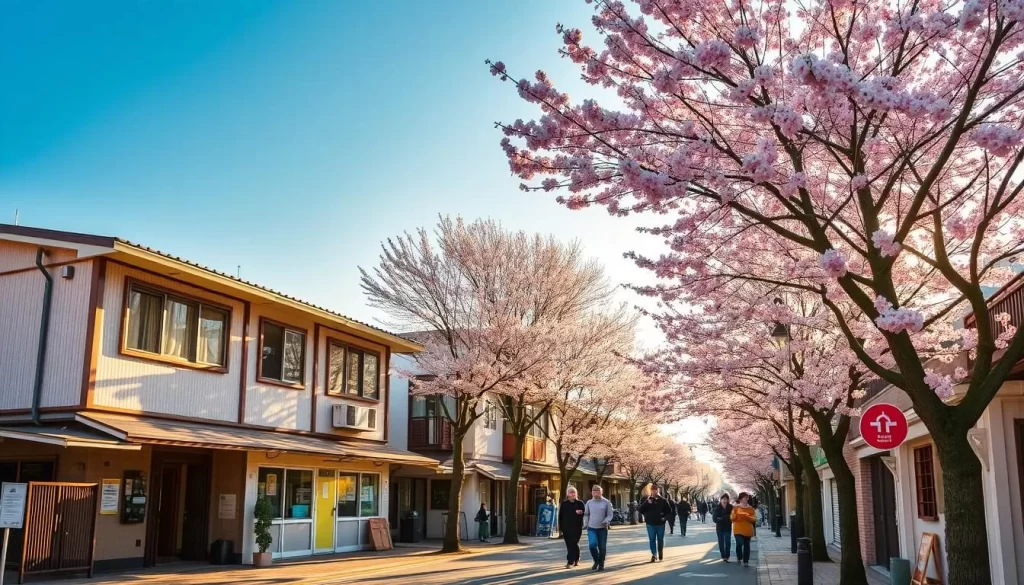
Location and Overview
Setagaya-ku, one of Tokyo’s 23 wards, is a popular district that has evolved significantly over the years. Until recently, it was the largest ward by area, surpassed only when Ota Ward expanded to include Haneda Airport’s island. Much like Meguro-ku and Nakano, Setagaya-ku was merely a farming village on the outskirts of Edo.
Incorporated into Tokyo City in 1932 with a population of about 133,000, its population skyrocketed to around 800,000 during the high economic growth period and continues to grow. Today, Setagaya-ku is known for its excellent balance of urban convenience and residential comfort, with good transportation links to central Tokyo while maintaining plenty of green spaces.
- The ward covers an extensive area with diverse neighborhoods, each with its own distinct character and attractions that cater to different interests and preferences.
- You can appreciate how Setagaya offers a more authentic glimpse into everyday Tokyo life, away from the tourist-heavy central districts but still providing plenty of interesting places to explore.
- Setagaya has evolved from a farming village on the outskirts of old Edo (Tokyo) to become Tokyo’s most populous ward with approximately 910,000 residents.
- The Setagaya ward is known for its blend of traditional and modern living, making it a unique place within the city.
- On one side, it offers easy access to Tokyo’s central districts; on the other, it maintains a relaxed atmosphere, making it an attractive residential area with various areas to live and explore.
Setagaya-ku’s charm lies in its ability to balance development with the preservation of its natural beauty and historical heritage. As you explore this ward, you’ll discover a mix of old and new, from traditional temples to modern shopping districts, all contributing to its unique character.
Shimokitazawa: Tokyo’s Hipster Haven
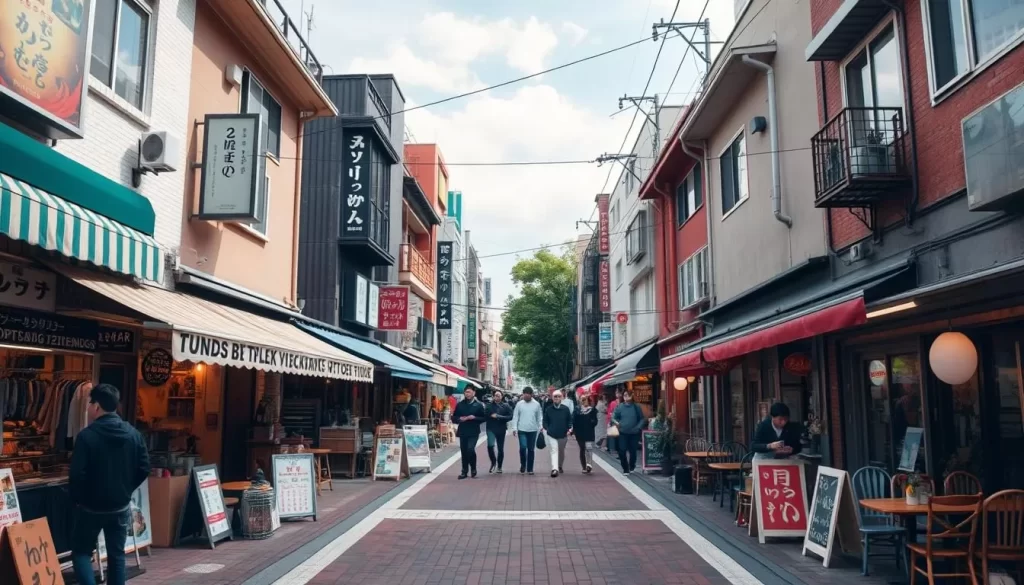
If you’re looking for a place that embodies Tokyo’s alternative culture, Shimokitazawa is the perfect destination. This charming neighborhood is a short train ride from Shibuya, making it an easily accessible yet distinctly different area that offers a more alternative, creative atmosphere.
Vintage Shopping Paradise
Shimokitazawa is renowned for its vintage shopping scene, with numerous second-hand clothing stores, record shops, and unique boutiques lining its narrow, pedestrian-friendly streets. You can spend hours exploring shops like New York Joe, housed in a renovated bathhouse, which offers carefully curated vintage items you won’t find anywhere else in Tokyo.
The area has a youthful energy thanks to its popularity among students and young creatives, giving it a distinctly different vibe from Tokyo’s more commercial shopping districts. As you wander through Shimokitazawa’s maze-like streets, you’ll discover hidden shops tucked away in corners, creating a treasure hunt-like experience as you explore this vintage paradise.
One of the standout features of Shimokitazawa is its ability to blend old and new. You’ll find trendy coffee shops and lively bars alongside traditional craft shops and pubs that frequently host live performances and workshops. This eclectic mix makes Shimokitazawa a fascinating place to explore, with something new to discover around every corner.
Along with Koenji, Shimokitazawa is a theatre and subculture district much appreciated by students and young people who have just moved to Tokyo. The Village Vanguard store is a notable landmark, offering a strangely spacious shopping experience amidst the crowded streets.
As you explore this vibrant neighborhood, you’ll find that Shimokitazawa’s charm lies in its ability to balance creativity with community. Whether you’re browsing through vintage clothing stores, enjoying live music at a local pub, or simply soaking up the atmosphere, Shimokitazawa is a place that will leave you with lasting memories of your time in Tokyo.
Sangenjaya: Where Tradition Meets Modern Tokyo
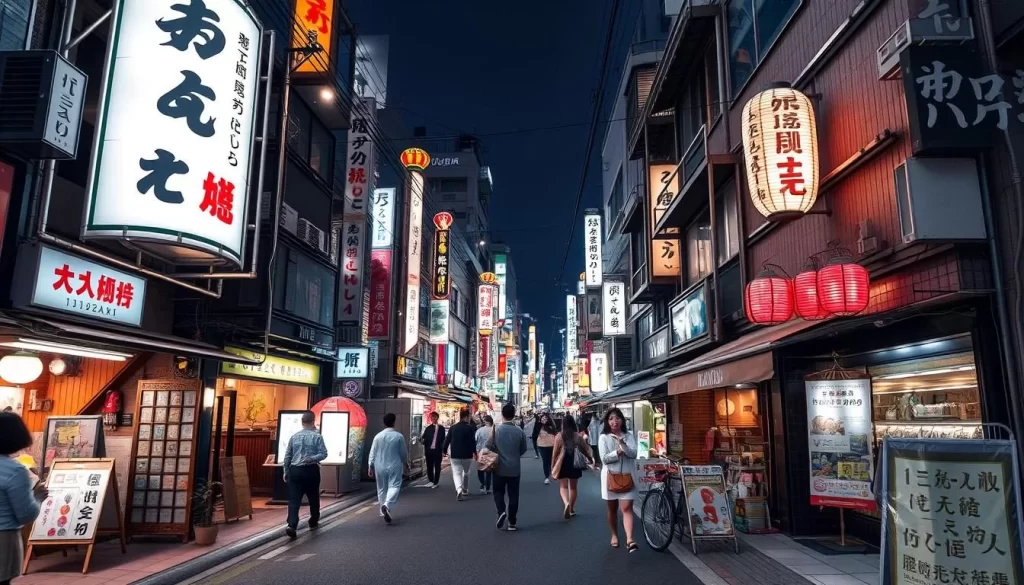
Discover the charm of Sangenjaya, a Tokyo neighborhood that masterfully blends the past with the present. Known affectionately as “Sancha” to locals, Sangenjaya is an area that has managed to retain its traditional atmosphere despite being a popular haunt for Tokyo’s hipsters. The name Sangenjaya, which translates to “three teahouses,” is derived from the three historic teahouses – Shigaraki, Kadoya, and Tanakaya – that once served travelers during the Edo period.
The Historic Triangle District
The heart of Sangenjaya is its historic Triangle District, or “Sankaku Chitai,” a place that offers a glimpse into post-war Tokyo. As you navigate the narrow streets, you’ll be surrounded by tiny bars and eateries that exude a nostalgic atmosphere, providing a unique experience that combines the old with the new.
You’ll discover that Sangenjaya earned its name from the three historic teahouses that once served travelers in this area during the Edo period. The neighborhood’s historic Triangle District offers you a glimpse into post-war Tokyo, with narrow alleyways filled with tiny bars and eateries that have a nostalgic atmosphere.
As you explore Sangenjaya, you can experience the place‘s unique blend of traditional and modern elements. Decades-old family businesses operate alongside trendy new cafés and boutiques, creating a vibrant atmosphere that is quintessentially Tokyo. The neighborhood has maintained its reputation as a dining destination from the Edo period to the present day, offering you countless options from traditional Japanese fare to international cuisine.
One of the highlights of visiting Sangenjaya is the opportunity to interact with people going about their daily lives. Unlike many other parts of Tokyo, Sangenjaya gives you a more authentic local experience, with fewer tourists and a more relaxed vibe. As you wander through the streets, you’ll uncover the rich history and cultural significance of this fascinating neighborhood.
Sangenjaya’s unique charm is also reflected in its dining scene, with a wide range of options to suit every taste. From traditional Japanese cuisine to modern international flavors, the neighborhood offers a culinary journey that is not to be missed. As you explore the local eateries and cafes, you’ll discover the perfect blend of traditional and modern flavors that Sangenjaya has to offer.
Gotokuji Temple: Home of the Lucky Cat
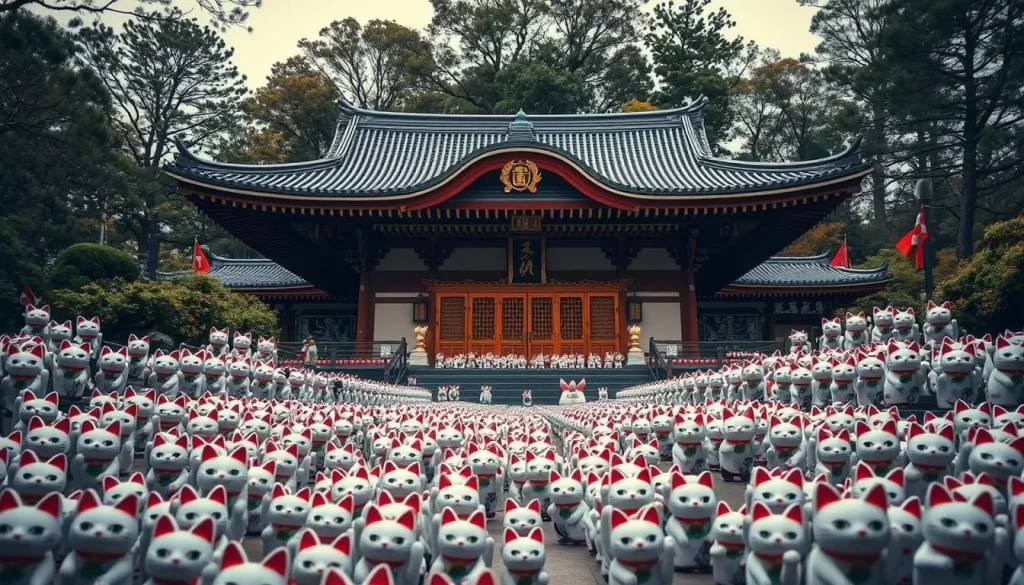
As you step into Gotokuji Temple in Setagaya-ku, Tokyo, you’ll be surrounded by the charm of Japan’s cultural heritage and the enchanting story of the maneki-neko.
Gotokuji Temple is a Soto sect temple located in Gotokuji 2-chome, Setagaya-ku, Tokyo. Built in 1480 by Kira Masatada, the lord of Setagaya Castle, the temple has a rich history. Today, it is famous for its countless maneki-neko figurines dedicated by visitors from all over.
The Legend of Maneki-Neko
The legend associated with Gotokuji Temple is deeply rooted in Japanese history, specifically during the Edo period. It is said that Ii Naotaka, the second lord of the Hikone Domain, took shelter in this very temple during a thunderstorm, beckoned by a cat. This anecdote has led to the temple’s association with the maneki-neko, or beckoning cat, a symbol believed to bring good fortune.
You can reach Gotokuji Temple by boarding the Setagaya Line and getting off at Miyanosaka Station. Upon visiting, you’ll be enchanted by the hundreds of beckoning cat statues of all sizes that adorn the place. The place is not just a spot of historical significance but also a spot where you can participate in a tradition by bringing your own maneki-neko to add to the collection, especially during January and February when many people visit to make offerings and wishes.
The Gotokuji Temple grounds are a unique and photogenic display, with maneki-neko figurines being added daily. The history of the temple, coupled with its serene atmosphere, makes it a must-visit destination in Setagaya-ku.
Todoroki Valley: Tokyo’s Hidden Natural Oasis
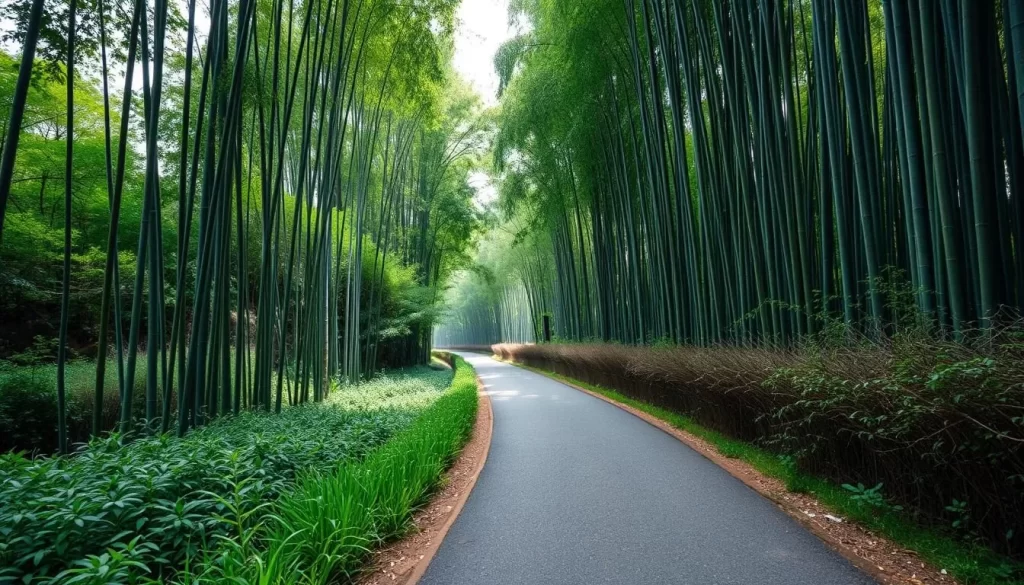
Escape to Todoroki Valley, Tokyo’s natural oasis, where the serene atmosphere and lush surroundings offer a refreshing respite from the city’s hustle and bustle. Located in Setagaya, one of Tokyo’s charming residential wards, this hidden gem is a must-visit destination for those seeking to connect with nature in the heart of the city.
Todoroki Valley is a unique place that spans 1.2 kilometers, offering a tranquil walking path along the Yazawa River. The valley is characterized by its bamboo trees and secret shrines, creating a cool microclimate even during Tokyo’s hot summer months. As you stroll through this beautiful area, the sounds of flowing water and rustling leaves envelop you, transporting you away from the urban noise.
Walking the Ravine Path
The ravine path in Todoroki Valley is a delightful experience, taking you on a journey through a lush landscape. As you walk, the serene surroundings and the gentle sound of the Yazawa River create a soothing atmosphere, perfect for relaxation. The path is well-maintained and offers a glimpse into the natural beauty that Tokyo has to offer, making it an ideal place to unwind and rejuvenate.
At the end of the valley lies Todoroki Fudo, an atmospheric temple known for its beautiful sakura in spring. This cultural landmark adds a rich layer to your visit, blending natural beauty with cultural exploration. The ease of access to Todoroki Valley, just a 5-minute walk from Todoroki Station on the Tokyu Oimachi Line and about 20 minutes from Shibuya, makes it a surprising yet accessible natural escape from the city.
Futako Tamagawa: Riverside Leisure and Shopping
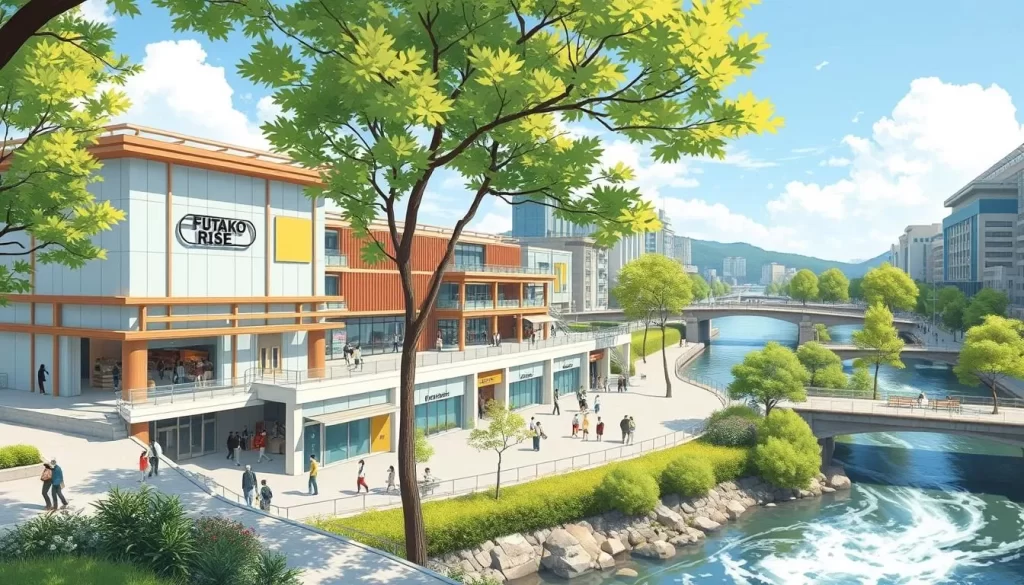
If you’re looking for a mix of urban convenience and natural beauty, Futako Tamagawa is the perfect destination in Tokyo. Located in the south of Sangenjaya, this upscale neighborhood is near the river banks of the Tama River and is a popular place to live.
Futako Tamagawa is home to some giant, modern shopping malls like Takashimaya, but the area surrounding Futako Tamagawa Station also offers some authentic experiences at local shops and restaurants. You can enjoy a sophisticated mix of retail, dining, and entertainment options in this vibrant area.
Futako Tamagawa Rise Shopping Complex
Futako Tamagawa Rise is directly connected to Futako Tamagawa Station on the Tokyu Denentoshi Line and Oimachi Line. It is a major leisure facility that combines commercial establishments with many hotspots, popular restaurants, a cinema complex, a fitness club, a hotel, and even a park. You’ll find Futako Tamagawa Rise to be one of Tokyo’s most impressive shopping complexes, offering a perfect blend of urban convenience and natural beauty.
The complex serves as more than just a shopping destination, functioning as a community hub with various event spaces that host activities throughout the year. You can shop at upscale stores in the Rise complex or Takashimaya department store, then explore the surrounding place for more authentic local shops and restaurants that showcase a different side of Tokyo retail.
Futakotamagawa Park is a spacious riverside park, great for picnics, long strolls, and cycling. You can also find a beautiful Japanese garden in the park as well as a children’s playground. In October, hundreds of thousands of people flock to the Tama River to watch the beautiful fireworks of the Tama River Fireworks Festival.
The thoughtful urban design of Futako Tamagawa integrates indoor shopping areas with outdoor spaces, creating a pleasant environment regardless of the weather or season. You can appreciate the scenic views of the Tama River while enjoying the various amenities at Futako Tamagawa Station and its surrounding Futako Tamagawa neighborhood.
Parks and Green Spaces in Setagaya-ku
Discover the natural beauty of Setagaya-ku through its many parks and green spaces, each offering a unique experience. Setagaya-ku is renowned for its numerous parks and gardens that provide a tranquil escape from the hustle and bustle of Tokyo city life.
You can explore various parks, each with its own character and attractions. From sports facilities to art museums, these green spaces cater to a wide range of interests and age groups.
Kinuta Park
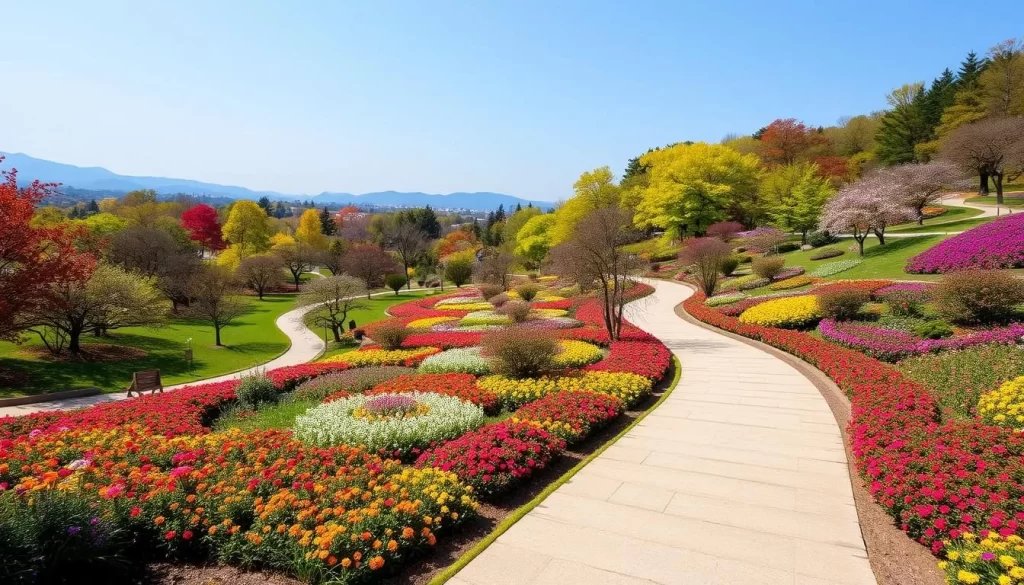
Kinuta Park is one of Setagaya’s largest green areas, boasting a rich history that dates back to its use as an air defense space during the war and later as a metropolitan golf course. Today, it stands as a multifaceted park designed for family enjoyment.
The park features a variety of recreational facilities, including sports fields, walking paths, and seasonal flower displays. You can enjoy a leisurely walk under the shade of numerous trees, making it an ideal place for relaxation.
One of the park’s highlights is the Setagaya Art Museum, located within its grounds. You can combine outdoor activities with a visit to the museum, creating a perfect day out for both nature lovers and art enthusiasts.
Kinuta Park hosts various seasonal events, such as the Tanabata Festival and bird-watching activities. These events provide multiple reasons to visit the park throughout the year, each offering a unique experience.
The park is designed with families in mind, offering spaces and activities that appeal to visitors of all ages. From children’s play areas to quiet spots for relaxation, Kinuta Park is a versatile green space that meets the needs of its diverse visitors.
In addition to Kinuta Park, Setagaya-ku is home to other notable parks, such as Setagaya Park, which features sports facilities, a fountain plaza, and a play park. On weekends, a mini SL “Chibikuro-go” runs through the park, delighting families and visitors alike.
These parks not only provide recreational areas but also contribute to the aesthetic appeal of Setagaya-ku, making it a desirable place to live and visit.
Setagaya-ku, Tōkyō, Japan: Best Things to Do for Art and Culture Lovers
Art lovers visiting Tokyo should not miss Setagaya-ku, a ward that boasts an impressive array of cultural attractions and activities. This charming area is home to numerous art museums, galleries, and cultural events that showcase both traditional and contemporary Japanese art.
Setagaya Art Museum
The Setagaya Art Museum is a must-visit destination for art enthusiasts. Located in Kinuta Park, the museum’s building was designed by architect Shozo Uchii, seamlessly integrating with the surrounding lush green landscape. The museum’s collection comprises approximately 16,000 items, including notable works such as Henri Rousseau’s “Portrait of Frumance Biche” and Kitaoji Rosanjin’s “The Year of the Fish.”
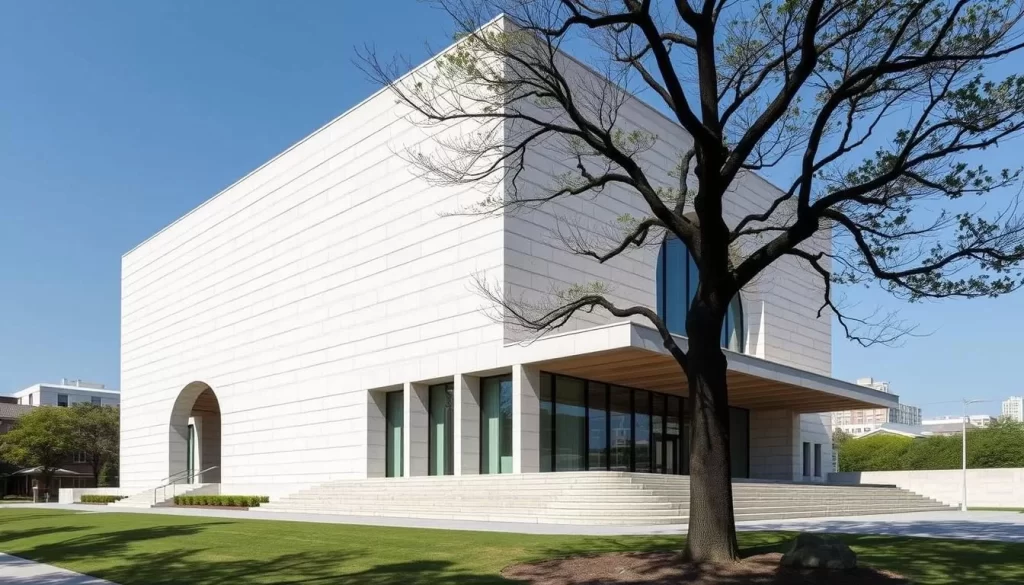
The museum offers a diverse range of exhibitions, including themed collection exhibitions and special exhibitions in collaboration with museums in Japan and abroad. Visitors can enjoy both the permanent collection and rotating exhibitions, ensuring a unique experience with each visit. The museum serves as a cultural anchor for the Setagaya Ward area, highlighting both international masterpieces and works that reflect the local history and character.
After exploring the exhibitions, you might want to relax at the museum’s French restaurant, which offers beautiful views overlooking Kinuta Park. This refined dining experience is the perfect way to conclude your visit to the museum.
In summary, the Setagaya Art Museum is a cultural gem in the heart of Tokyo, providing an enriching experience for art lovers. With its impressive collection, thoughtful architectural design, and beautiful surroundings, it is a place that should be on every art enthusiast’s itinerary when visiting Setagaya Ward.
Hidden Gems of Setagaya-ku
For those looking to explore beyond Tokyo’s central districts, Setagaya-ku presents a fascinating array of hidden gems. This charming ward is home to a mix of traditional and modern attractions that offer a unique glimpse into Tokyo’s diverse character.
Setagaya Line Tram Experience
The Tokyu Setagaya Line is one of only two surviving tramways in Tokyo, offering a nostalgic transportation experience that differs significantly from the city’s modern train systems. You’ll delight in riding this charming tram, which weaves through residential neighborhoods between Shimotakaido and Sangenjaya stations.
The two-car trams are particularly photogenic, especially in June when hydrangeas bloom along the tracks, creating picturesque scenes that capture a more romantic side of Tokyo. As you ride the Setagaya Line, you’ll get glimpses of local life that most tourists never see, making it a great way to experience the area at a slower pace.
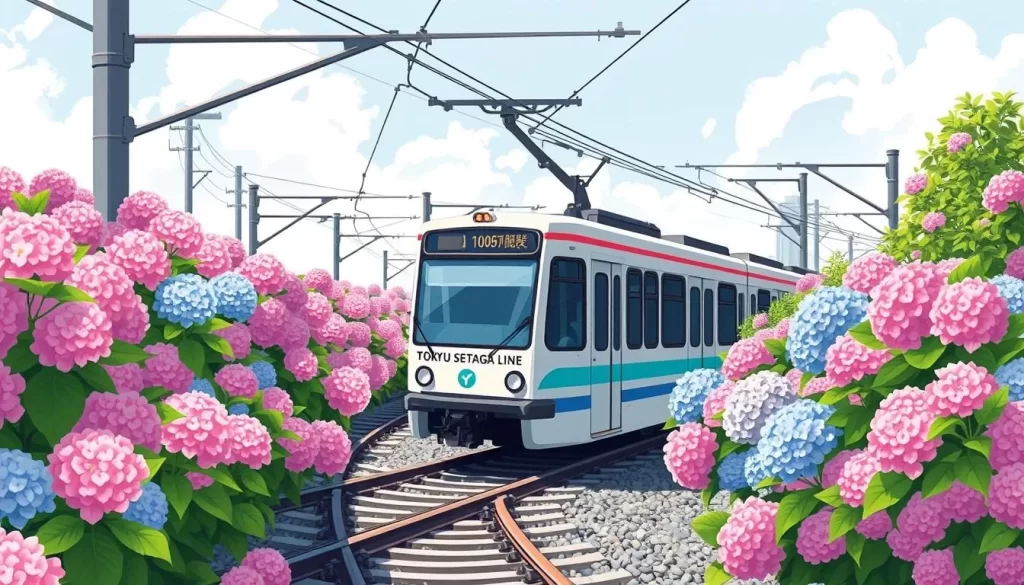
The Setagaya Line is more than just a mode of transportation; it’s an experience that allows you to enjoy the scenic views of the surrounding place. With the tram winding through narrow streets and past small, picturesque crossings, you’ll feel as though you’re exploring a different side of Tokyo. To complement your tram experience, consider visiting the free observatory in Carrot Tower in Sangenjaya, where you can get a bird’s-eye view of the tram line curving through the neighborhood below.
After exploring the Setagaya Line, you can further discover the charm of Sangenjaya, a great area to visit for an authentic experience. The close proximity to central Tokyo, numerous green spaces, and variety of shops make it an ideal place to spend the day. Whether you’re interested in history, culture, or simply enjoying a relaxed atmosphere, Sangenjaya has something to offer.
Seasonal Highlights and Events in Setagaya
Experience the best of every season in Setagaya-ku, where nature’s beauty is always on display. You’ll find that the ward offers a unique charm throughout the year, making it a perfect destination for those who appreciate the changing seasons.
Cherry Blossom Viewing Spots
Spring in Setagaya offers spectacular cherry blossom viewing opportunities, with several parks and riverside locations providing perfect spots to enjoy this beloved Japanese tradition. The cherry trees along the Tama River create a stunning pink corridor during late March to early April, giving you both natural beauty and a festive atmosphere as locals gather for hanami (flower viewing) parties.
One of the notable spots is Hanegi Park, which is about a 5-minute walk from Umegaoka Station and a 7-minute walk from Higashimatsubara Station. Although it’s famous for its plum blossoms or ume trees, the park also offers beautiful scenery in other seasons.
- You’ll find that spring in Setagaya offers spectacular cherry blossom viewing opportunities, with several parks and riverside locations providing perfect spots to enjoy this beloved Japanese tradition.
- The cherry trees along the Tama River create a stunning pink corridor during late March to early April, giving you both natural beauty and festive atmosphere as locals gather for hanami (flower viewing) parties.
- You can experience the earlier-blooming plum blossoms at Hanegi Park from early February to early March, where 650 ume trees of about 60 varieties create a fragrant and colorful display before the cherry season begins.
Beyond cherry blossoms, the changing seasons bring different natural highlights throughout the year. From fresh spring greenery to the golden colors of autumn, making Setagaya worth visiting in any season. You’ll appreciate how seasonal events are woven into the local calendar, with special festivals and activities organized around natural phenomena like cherry blossoms, creating memorable cultural experiences.
The Todoroki Valley is another place where you can enjoy the seasonal beauty. From the signboard at the entrance of the ravine at the foot of the golf bridge, visitors can descend a flight of stairs to find a natural setting that makes it hard to believe they are in the city. They can see a variety of seasonal colours: plum blossoms in February, cherry blossoms in April, fresh greenery in May, and yellow maple trees in autumn.
Family-Friendly Activities in Setagaya-ku
For a fun-filled experience in Tokyo, consider visiting Setagaya-ku with your family. This charming ward is packed with activities that cater to children of all ages, making it an ideal destination for families.
Setagaya Park and Mini Steam Train
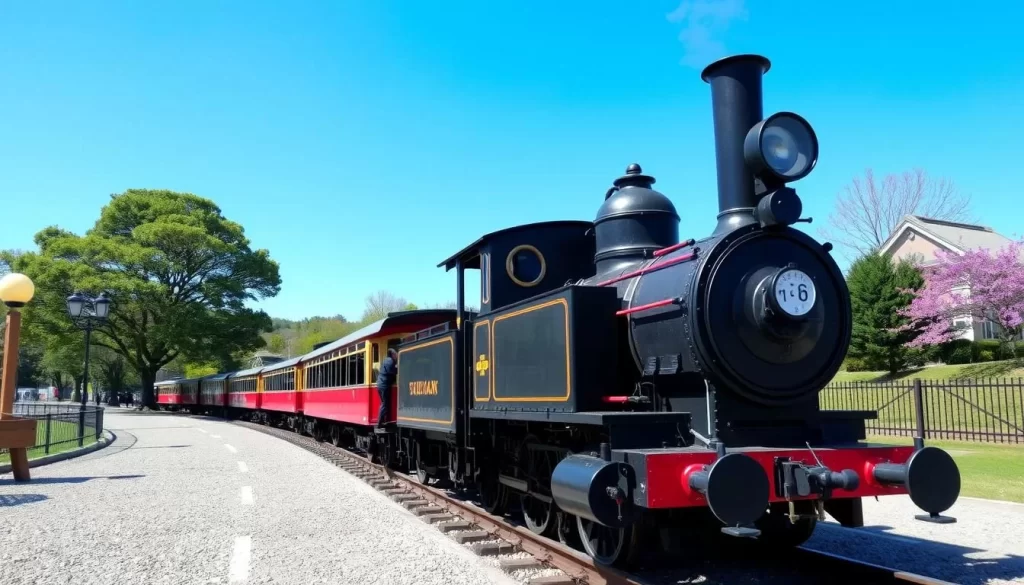
Setagaya Park, located in Ikejiri, Setagaya Ward, is a vast urban park spanning approximately 78,000 square meters. It is a beautiful place to visit throughout the year, offering various amenities such as sports facilities, a fountain plaza, and a play park. On Saturdays and Sundays, the park comes alive with the chugging of the mini SL “Chibikuro-go,” a steam train that runs through the park, captivating children and adults alike.
The mini steam train offers a 3-minute loop ride for just ¥50, providing an affordable and enjoyable experience for families. Additionally, the park features a Traffic Park where children can learn about traffic rules and safety while driving miniature cars on specially designed streets.
During the summer months, the park’s outdoor swimming pool is a refreshing oasis, offering a cool respite from Tokyo’s hot season. The park’s beauty changes with the seasons, with cherry blossoms blooming in spring and golden ginkgo trees in autumn, creating different experiences for repeat visits with your family.
You’ll find Setagaya Park to be a perfect family destination, offering various activities for children throughout the year. The park’s unique blend of recreational and educational activities makes it a place worth visiting multiple times.
Culinary Journey Through Setagaya-ku
In Setagaya-ku, you’ll discover a vibrant food scene that seamlessly blends traditional Japanese eateries with international flavors. This ward of Tokyo is a culinary gem, offering a diverse range of dining experiences that cater to all tastes and preferences.
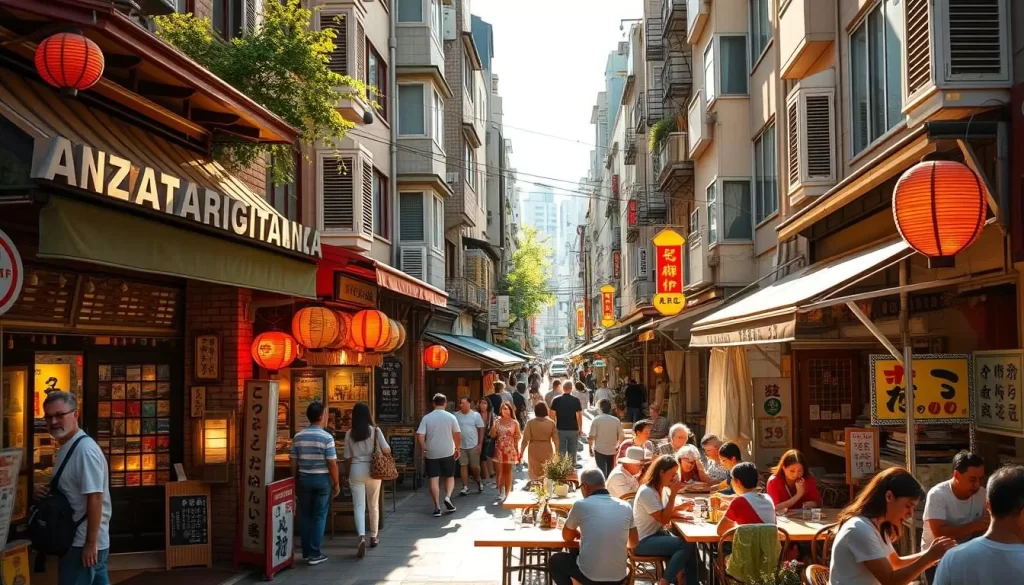
Local Specialties and Dining Districts
Setagaya-ku’s culinary landscape is characterized by its unique dining districts, each offering a distinct gastronomic experience. Sangenjaya, known affectionately as Sancha, is one such area that stands out for its relaxed vibe and blend of traditional and modern dining options. Here, you can enjoy local eateries like Gyoza Shack and Garyu, which serve a fusion of traditional flavors with contemporary twists.
The “Triangle District” in Sangenjaya is another culinary hotspot, where tiny bars and restaurants create an atmospheric dining experience reminiscent of old Tokyo. This historic place has been a dining destination for centuries, continuing its legacy into the present day.
- Explore the narrow streets of Sangenjaya, dotted with fashionable cafes and local eateries.
- Visit the shopping street in front of Sangenjaya Station, known for its Chinese restaurants and unique dining options like pak choi cuisine.
- Discover unique food experiences, such as Granny Smith Pie near Setagaya Park, perfect for a picnic.
As you journey through Setagaya-ku, you’ll find that the food scene is not just about eating; it’s an experience that brings people together. Whether you’re dining at a traditional Japanese restaurant or enjoying a meal at one of the many international eateries, you’re experiencing the area‘s rich culinary culture in a unique way.
Shimokitazawa offers a youthful and international food scene, with numerous cafes serving specialty coffee and restaurants offering cuisine from around the world. This makes it an ideal place to explore for those looking for a diverse dining experience.
Shopping Experiences in Setagaya-ku
You’ll find that shopping in Setagaya Ward provides a more genuine experience compared to Tokyo’s larger commercial districts. The area is home to a variety of shopping experiences, ranging from traditional shopping streets to modern retail areas.
Traditional Shopping Streets
Setagaya Ward is dotted with traditional shopping streets, known as “shotengai,” which have been serving local communities for generations. One such historic shopping street is Shoin Jinja Dori Shotengai, which offers a glimpse into old Tokyo commerce. Here, you can find establishments like Nikorasu Seiyodo Bakery, which has been around since 1912, alongside newer businesses.
The “Triangle Zone” in Sangenjaya is another vibrant shopping district that evolved from a post-war market area into a diverse commercial hub. This area offers a mix of shopping experiences, from small family-owned specialty shops to more modern retail areas along the various train lines that cross through the ward.
- Explore the historic Shoin Jinja Dori Shotengai shopping street, lined with shops and cafes.
- Visit the “Triangle Zone” in Sangenjaya for a diverse shopping experience.
- Discover local specialties and traditional goods at family-owned shops.
Some popular items to try while shopping in Setagaya include amazake cappuccino at Setagaya Engawa cafe and freshly baked snacks at Nikorasu Seiyodo Bakery. The area’s shopping streets are not just about shopping; they’re also about experiencing the local culture.
| Shopping Area | Notable Features | Must-Try |
|---|---|---|
| Shoin Jinja Dori Shotengai | Historic shopping street with traditional shops and cafes | Amazake cappuccino at Setagaya Engawa cafe |
| “Triangle Zone” in Sangenjaya | Diverse commercial hub with mix of old and new shops | Freshly baked snacks at Nikorasu Seiyodo Bakery |
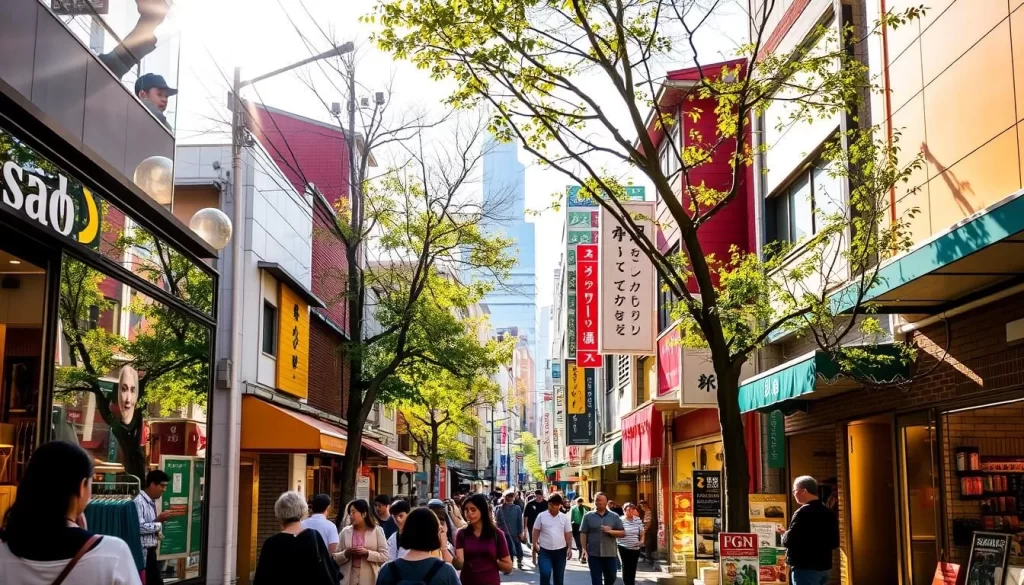
The shopping areas in Setagaya Ward maintain their distinct local character while offering plenty of variety, making them interesting places to explore even if you’re not planning to buy anything. Whether you’re looking for traditional goods or modern retail therapy, Setagaya Ward has something to offer.
In the Setagaya Ward area, you’ll find a place that seamlessly blends traditional shopping streets with modern shopping experiences, making it a unique shopping destination in the city.
Day Trip Itineraries in Setagaya-ku
If you’re looking for a deep dive into Japan’s history and culture, Setagaya-ku is the place to be. This ward of Tokyo is replete with historical sites, cultural landmarks, and traditional areas that offer a glimpse into the past. One of the best ways to experience this is by following a day trip itinerary that covers the key cultural and historical spots.
Cultural and Historical Route
Setagaya-ku is home to numerous historical and cultural sites, making it an ideal location for a day trip focused on exploring Japan’s heritage. A cultural and historical route through Setagaya could start at the famous Gotokuji Temple, known as the birthplace of the lucky cat, and proceed to lesser-known sites like Karasuyama Temple Town.
Karasuyama Temple Town is a significant historical area with 26 Buddhist temples located in close proximity to each other. The area is relatively free of pedestrians and traffic, making it an ideal place for exploration. While visiting all 26 temples is not necessary, Myouji Temple stands out for its large temple buildings and residences. Additionally, Shoin Shrine is a must-visit, dedicated as it is to Shoin Yoshida, an influential figure from the Edo period who advocated for modernization and the restoration of imperial power.
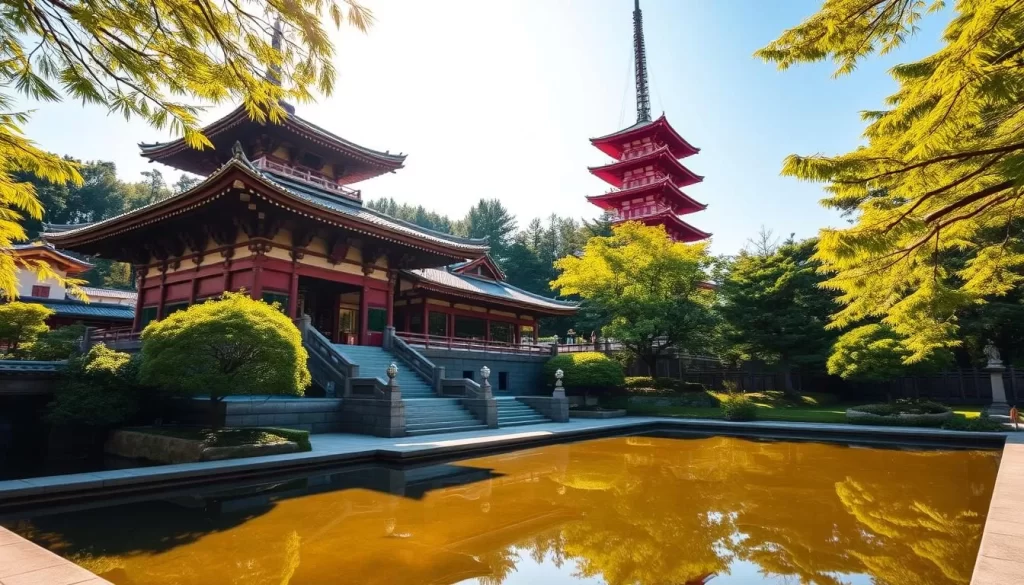
The cultural route can be enriched by including visits to museums such as the Setagaya Art Museum and the Gotoh Museum, which house significant collections of Japanese and international art. This blend of historical sites and cultural institutions provides a comprehensive understanding of Setagaya-ku’s history and its development from agricultural villages into a part of modern Tokyo.
| Time | Location | Activity |
|---|---|---|
| 9:00 AM | Gotokuji Temple | Visit the birthplace of the lucky cat and explore the surrounding area. |
| 11:00 AM | Karasuyama Temple Town | Explore the 26 Buddhist temples, with a focus on Myouji Temple. |
| 1:00 PM | Local Restaurant | Lunch break, trying local cuisine. |
| 2:30 PM | Shoin Shrine | Visit the shrine dedicated to Shoin Yoshida and enjoy the sakura trees in spring. |
| 4:30 PM | Setagaya Art Museum or Gotoh Museum | Visit one of these museums to learn more about Japanese and international art. |
By following this cultural and historical route, you can gain a deeper understanding of Setagaya-ku’s rich history and cultural significance. Whether you’re interested in historical sites, cultural landmarks, or traditional areas, Setagaya-ku has something to offer.
Practical Information for Visiting Setagaya-ku
Whether you’re commuting from central Tokyo or exploring the local area, Setagaya-ku’s transportation infrastructure has got you covered. The ward is well-connected by various train lines, including the Keio Line, Odakyu Line, and Tokyu Denentoshi Line, making it easily accessible from central Tokyo areas like Shibuya and Shinjuku.
Getting Around
Navigating Setagaya-ku is straightforward, thanks to its comprehensive transportation network. The Tokyu Setagaya Line tram is a charming way to explore the ward, connecting Sangenjaya and Shimotakaido with stops at various points of interest along the way. You can hop on the train at a convenient station and travel to your desired place.
- The Keio Line and Inokashira Line intersect at a major transfer station, making it a busy hub in Setagaya.
- The Tokyu Setagaya Line tramway terminates at this station, adding to its importance.
- Renting a bicycle is also a great way to explore Setagaya, as the area is relatively flat and has good cycling infrastructure.
For those who prefer to walk, many of the ward’s major attractions are within walking distance of train stations. However, you’ll find that Google Maps is particularly helpful for navigating between sites in this sprawling residential area. You can easily plan your way around Setagaya-ku using this tool.
Setagaya-ku is a part of the larger city, and its location in the southwest makes it convenient to include in a broader Tokyo itinerary. Whether you’re visiting local landmarks like Gotokuji Temple or exploring the scenic Kinuta Park, you’ll find that the ward is a great addition to your Tokyo travel plans.
To further enhance your visit, consider exploring the surrounding area, which offers a glimpse into traditional Tokyo. With its rich history and modern attractions, Setagaya-ku is a place where you can experience the best of both worlds.
Conclusion: Why Setagaya-ku Should Be on Your Tokyo Itinerary
Discover the charm of Setagaya-ku, a Tokyo ward that seamlessly blends tradition, culture, and modernity. As you’ve explored throughout this article, Setagaya-ku offers a unique blend of local experiences that give you a more authentic taste of Tokyo life.
You’ll find that Setagaya-ku is a refreshing contrast to Tokyo’s more hectic areas, with abundant green spaces like Todoroki Valley and Kinuta Park where you can recharge between urban explorations. The ward’s diverse neighborhoods, such as Shimokitazawa and Futako Tamagawa, provide multiple experiences within one area, from hipster havens to riverside sophistication.
The cultural treasures throughout Setagaya-ku, including the lucky cat temple of Gotokuji and various shrines, museums, and historic neighborhoods, tell the story of Tokyo’s development. Sangenjaya is a great area to visit when you’re looking for an authentic experience, with its numerous shops, stylish cafes, and trendy boutiques.
As you plan your Tokyo itinerary, make sure to include Setagaya-ku. This ward represents the authentic Tokyo that locals are proud of, a place where real Tokyo residents live, work, and play. With its perfect balance of tourist attractions and local experiences, Setagaya-ku gives you a more complete picture of Tokyo life.
Using Google Maps or other navigation tools can help you explore the area efficiently. Whether you’re interested in history, culture, or simply experiencing the local lifestyle, Setagaya-ku has something to offer. So, take the opportunity to visit this charming ward and discover why so many Tokyo residents are proud to call it home.
The above is subject to change.
Check back often to TRAVEL.COM for the latest travel tips and deals.






